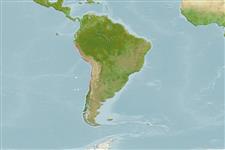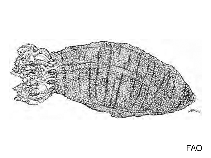Athyonidium chilensis (Semper, 1868)
Burrowing shaggy sea cucumber| Native range | All suitable habitat | Point map | Year 2050 |

|
| This map was computer-generated and has not yet been reviewed. |
| Athyonidium chilensis AquaMaps Data sources: GBIF OBIS |
Classification / Names Common names | Synonyms | CoL | ITIS | WoRMS
Holothuroidea | Dendrochirotida | Phyllophoridae
Environment: milieu / climate zone / depth range / distribution range Ecology
Benthic; depth range 0 - 7 m (Ref. 87801). Temperate; 7°S - 47°S, 82°W - 70°W (Ref. 107069)
Distribution Countries | FAO areas | Ecosystems | Occurrences | Introductions
Southeast Pacific: Peru and Chile.
Length at first maturity / Size / Weight / Age
Maturity: Lm ? range ? - ? cm
It is found near kelp holdfasts Macrocystis, and on sand and rock from the intertidal to a depth of 7 m (Ref. 87801). Partially or fully buried in the intertidal in areas with rocks with great quantity of organic matter. Feeds on microalgae, detritus (Ref. 92930), macroalgae, gastropods, bivalves, barnacles, chitons and crabs (Ref. 107003).
Life cycle and mating behavior Maturity | Reproduction | Spawning | Eggs | Fecundity | Larvae
Members of the class Holothuroidea are gonochoric and have only one gonad. Spawning and fertilization are both external and some exhibit brooding. Life cycle: Embryos develop into planktotrophic larvae (auricularia) then into doliolaria (barrel-shaped stage) which later metamorphose into juvenile sea cucumbers.
Main reference
References | Coordinator | Collaborators
Servicio Nacional de Pesca y Acuicultura. 2011. (Ref. 90098)
IUCN Red List Status (Ref. 130435)
CITES status (Ref. 108899)
Not Evaluated
CMS (Ref. 116361)
Not Evaluated
Threat to humans
Harmless
Human uses
Fisheries: commercial
| FishSource |
Tools
More information
Age/Size
Growth
Length-weight
Length-length
Morphology
Larvae
Abundance
Growth
Length-weight
Length-length
Morphology
Larvae
Abundance
Internet sources
BHL | BOLD Systems | CISTI | DiscoverLife | FAO(Publication : search) | Fishipedia | GenBank (genome, nucleotide) | GloBI | Gomexsi | Google Books | Google Scholar | Google | PubMed | Tree of Life | Wikipedia (Go, Search) | Zoological Record
Estimates based on models
Preferred temperature
(Ref. 115969): 13.8 - 20.6, mean 19.4 (based on 64 cells).



